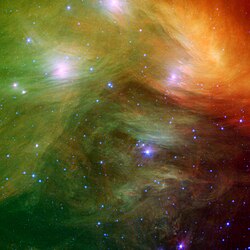| Observation data Epoch J2000 Equinox J2000 | |
|---|---|
| Constellation | Taurus |
| Right ascension | 03h 46m 19.5859s[1] |
| Declination | +23° 56′ 54.092″[1] |
| Apparent magnitude (V) | 4.18[2] |
| Characteristics | |
| Spectral type | B6IV(e)[3] |
| U−B color index | −0.41[4] |
| B−V color index | −0.06[4] |
| Variable type | β Cephei[5] |
| Astrometry | |
| Radial velocity (Rv) | 6.2[6] km/s |
| Proper motion (μ) | RA: 13.075[1] mas/yr Dec.: −48.404[1] mas/yr |
| Parallax (π) | 7.0670±0.2862 mas[1] |
| Distance | 460 ± 20 ly (142 ± 6 pc) |
| Absolute magnitude (MV) | −1.29[7] |
| Details | |
| Mass | 4.25[8] M☉ |
| Radius | 4.79±0.17[9] R☉ |
| Luminosity | 927[10] L☉ |
| Surface gravity (log g) | 3.48[10] cgs |
| Temperature | 14,550[10] K |
| Rotational velocity (v sin i) | 240[10] km/s |
| Age | 212[11] Myr |
| Other designations | |
| Merope, 23 Tau, V971 Tauri, HR 1156, BD+23°522, HD 23480, HIP 17608, SAO 76172, GC 4512, CCDM J03463+2357A | |
| Database references | |
| SIMBAD | data |
Merope /ˈmɛrəpiː/,[12] designated 23 Tauri (abbreviated 23 Tau), is a star in the constellation of Taurus and a member of the Pleiades star cluster. It is approximately 440 light-years (135 pc) away.

Despite being one of the closest star clusters to Earth, the distance to the Pleiades and its member stars is still in dispute. The parallax of Merope itself is not known precisely enough to give an accurate distance. Its Hipparcos parallax has a statistical margin of error of about 5% and gave a distance 116 parsecs. This, and an overall distance to the Pleiades calculated from Hipparcos parallaxes of 120 parsecs, are inconsistent with other parallax measurements such as from Gaia. Merope is too bright for Gaia to have a reliable parallax for it, but calculations of the overall distance to the Pleiades cluster using Hipparcos, Gaia, Hubble Space Telescope, and other methods repeatedly show that the Hipparcos parallaxes suffered from some kind of systemic error, and the distance to the Pleiades is most likely around 135 parsecs.[13][14][15][16][17]

Merope is a blue-white B-type subgiant with a mean apparent magnitude of +4.18. Richard Hinckley Allen described the star as lucid white and violet.[18] It has a luminosity of 927 times that of the Sun and a surface temperature of 14,550 K. Merope's mass is roughly 4.25 M☉ and has a radius 4.8 times as great as the Sun's.
In 1985, Bernard J. McNamara announced that the brightness of Merope varies as a function of time.[19] Merope is classified as a Beta Cephei variable, a type of hot variable star which pulsates regularly due to opacity changes in its atmosphere. Its brightness varies by up to 0.01 magnitudes during each pulsation cycle.[5] It is given the variable star designation of V971 Tauri. The period of variability is stable at 0.49 days, although the amplitude of the brightness changes on each cycle varies.[9]
Some papers have reported a companion star to Merope, at a separation of 250 mas, as well as several other visual companions farther out. These possible companions have not been confirmed.[20]
Surrounding Merope is the Merope Nebula (NGC 1435). It appears brightest around Merope and is listed in the Index Catalogue as number IC 349.
23 Tauri is the star's Flamsteed designation. The name Merope originates with Greek mythology; she is one of the seven daughters of Atlas and Pleione known as the Pleiades. In 2016, the International Astronomical Union organized a Working Group on Star Names (WGSN)[21] to catalog and standardize proper names for stars. The WGSN's first bulletin of July 2016[22] included a table of the first two batches of names approved by the WGSN; which included Merope for this star. It is now so entered in the IAU Catalog of Star Names.[23]